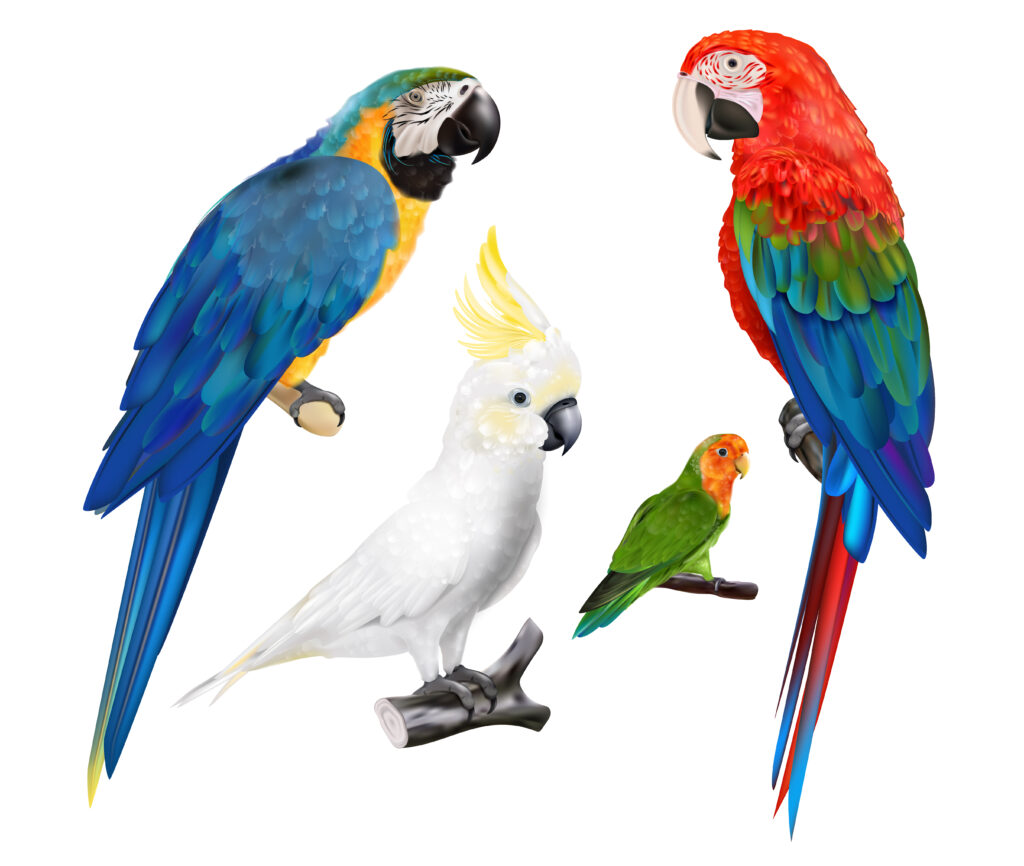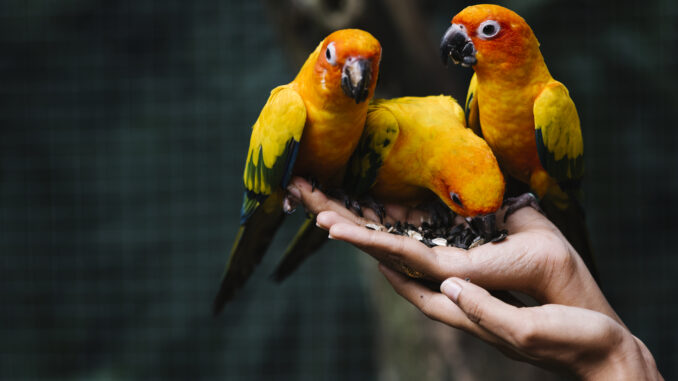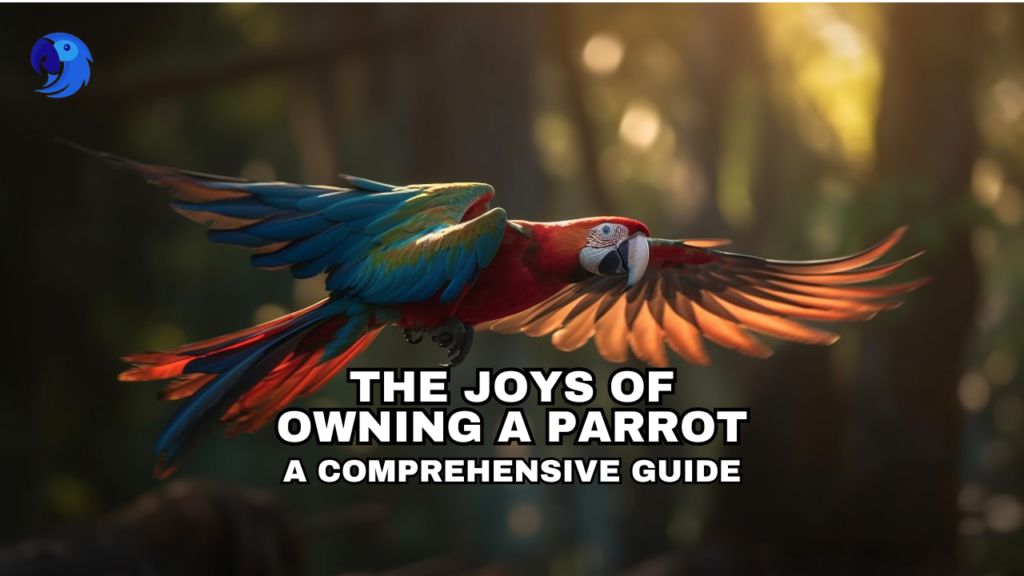Parrot ownership isn’t just about having a bird in your living room; it’s about welcoming a colorful and intelligent companion into your life. These avian friends are known for their dynamic personalities, their playful antics, and the strong bonds they form with their human counterparts. The joy they bring can be akin to the companionship of a dog or cat, wrapped in vibrant feathers and a unique ability to communicate.
In this guide, we’ll explore every aspect of parrot ownership, from choosing the right species to ensuring they thrive in your care. Whether you’re a first-time bird owner or an experienced avian enthusiast, this comprehensive guide aims to enrich your journey with parrots.
Choosing the Right Parrot
Factors to Consider
- Size and Space Requirements: Parrots come in various sizes, from small budgies to large macaws. Consider the space you have available before selecting a species. A larger parrot will require a substantially larger cage and play area.
- Longevity and Life Commitment: Some parrot species have impressively long lifespans. For instance, African Grey Parrots can live up to 60 years. Preparing for a long-term commitment is essential before bringing one home.
- Temperament and Personality Traits: Parrots have distinct personalities. While some are outgoing and social, others prefer more solitude. Research the specific traits of different species to find one that matches your household dynamics.
Popular Parrot Species

- Budgerigars (Budgies): These small parrots are known for their mimicry and friendly nature. They’re great for beginners, requiring moderate care with a playful attitude.
- African Grey Parrots: Renowned for their intelligence, African Grey Parrots can understand human emotions and boast remarkable conversational abilities. However, they need mental stimulation and interaction.
- Macaws: Macaws are stunningly colorful and highly social birds. They necessitate plenty of attention and a large living space to meet their active lifestyle.
1.3 Matching Your Lifestyle
- Assessing Time and Attention Availability: Parrots are social creatures that require time and interaction. Ensure you have ample time for engagement and care.
- Space Considerations for Larger Species: Larger birds like macaws and cockatoos need more space. Adequate room for a large cage and play area is crucial.
- The Importance of Research Before Choosing: Each parrot species has different needs. Learn about them before deciding which bird is your ideal companion.
Creating a Suitable Environment
Cage Setup and Size
- Determining Appropriate Cage Dimensions: As a rule of thumb, a parrot’s cage should be at least twice the bird’s wingspan in all dimensions.
- Optimal Placement for Safety and Comfort: Keep the cage away from direct sunlight, drafts, and high-traffic areas to provide security.
- Regular Cleaning and Maintenance Tips: Clean the cage regularly to prevent bacterial growth and ensure a healthy environment for your bird.
Enrichment and Stimulation
- Variety of Toys for Mental and Physical Engagement: Provide varied toys to stimulate your parrot’s mind and body. Rotate them weekly to keep your bird engaged.
- The Role of Foraging in Daily Activities: Encourage natural behaviors by incorporating foraging activities. Hide treats in toys or scatter food around their play area.
- Importance of Rotating Toys to Prevent Boredom: Change toys frequently to stimulate and entertain your parrot.
Perches and Accessories
- Different Materials and Shapes for Foot Health: Use perches of various textures like wood and rope to support foot health and prevent sores.
- Placement and Variety to Simulate Natural Habitat: Position perches at different heights and angles to replicate a bird’s natural environment.
- Additional Items: Ladders, Swings, and Stands: Offer ladders and swings to enhance their play environment, promoting exercise and agility.
Nutrition and Diet

Essential Dietary Components
- Pellets and Their Role in Balanced Nutrition: Pellets provide a nutritionally balanced diet. Look for reputable brands and avoid those high in artificial ingredients.
- Avoiding Nutrient Deficiencies: Ensure your parrot’s diet isn’t limited to seeds, as this can lead to deficiencies. Incorporate a balanced mixture of food types.
Fresh Fruits and Vegetables
- Safe and Healthy Options: Offer a variety of fresh produce such as apples, carrots, and leafy greens. Avoid toxic foods like avocado and chocolate.
- Serving Sizes and Preparation Tips: Cut fruits and vegetables into manageable, bite-sized pieces to prevent choking.
- Benefits of a Diverse Diet for Vitality: A varied diet ensures your parrot receives all the essential nutrients for a vibrant and healthy life.
Treats and Supplements
- Seeds and Nuts as Occasional Treats: These can be offered sparingly due to their high fat content.
- Monitoring for Potential Obesity and Overfeeding: Watch for weight gain and adjust the diet accordingly to avoid health issues.
- Supplementing with Calcium and Other Nutrients: Consider additives like calcium, especially for breeding females or if your vet recommends it.
Training and Socialization
Basic Training Techniques
- Steps for Successful Clicker Training: Use a clicker as a cue for positive reinforcement when teaching new behaviors.
- Teaching Basic Commands and Tricks: Start with simple commands like “step up.” Build up to more complex tricks as your parrot learns.
- Establishing a Routine and Setting Goals: Consistent training schedules help reinforce learning and establish expectations.
Building a Strong Bond
- Social Interaction and Playtime Strategies: Spend quality playtime with your parrot. They love social interaction, whether through talking, playing, or exploring together.
- Reading Body Language and Cues: Learn to interpret your parrot’s body language to understand their feelings and needs.
- The Role of Patience and Consistency: Training takes time, and patience is key. Consistency in interactions fosters trust and understanding.
Problem-Solving Common Issues
- Handling Unwanted Behaviors: Identify the root cause of behaviors like screeching or biting and address them with patience.
- Adjusting Training Methods to Suit the Parrot’s Needs: Adapt your approach based on your parrot’s reaction and personality.
- Importance of Positive Reinforcement: Reward good behaviors with treats and affection to encourage repeated actions.
Health and Veterinary Care

5.1 Routine Health Maintenance
- Scheduling Regular Veterinary Check-Ups: Annual vet visits are crucial for preventive care and early disease detection.
- Recognizing Early Signs of Illness: Watch for changes in eating, droppings, or behavior, which could indicate health issues.
- Daily and Seasonal Health Checks: Perform quick daily health checks and more thorough seasonal exams at home to track your bird’s well-being.
5.2 Common Parrot Health Issues
- Psittacosis: Symptoms and Prevention: This contagious disease requires prompt vet attention and quarantine measures for prevention.
- Feather Plucking: Causes and Remedies: Stress, boredom, or medical issues can lead to plucking. Address environmental and dietary factors, and seek vet advice.
- Other Ailments: Respiratory Issues, Beak Problems: Regular vet checks can help prevent these common issues from becoming severe.
5.3 Emergency Preparedness
- First Aid Essentials for Bird Owners: Keep a first aid kit handy with essentials like styptic powder and antiseptic wipes.
- Identifying When to Seek Veterinary Care: Trust your instincts—if you suspect something’s wrong, seek professional advice promptly.
- Creating a Safe Environment to Prevent Accidents: Bird-proof your home, removing hazards like toxic plants and open water sources.
Conclusion
Owning a parrot is a rewarding experience, offering endless fascination and affection. Their care requires commitment, but the joy they bring more than compensates. A long-term dedication to their health and happiness ensures a fulfilled companionship that’s rich and vibrant.
FAQs
- How long do parrots typically live?Parrots can live anywhere from 10 to 80 years, depending on the species. It’s essential to research lifespan expectations when choosing your bird.
- What is the best way to train my parrot? Start with basic commands using positive reinforcement techniques. Consistency and patience are crucial for effective training.
- How can I tell if my parrot is unwell? Look for signs like changes in appetite, feather condition, and behavior. If anything seems off, consult with your avian vet.
- Is it necessary to clip my parrot’s wings? Wing clipping is a personal choice. Consider the bird’s safety and your environment. Discuss with an avian vet if unsure.
- How do I introduce a new parrot to my home? Create a calm environment and gradually introduce your bird to its new space, allowing them to explore at their own pace.

